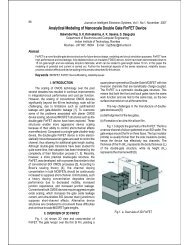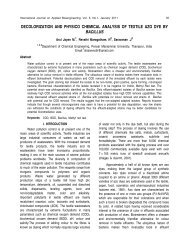Download Full Paper - Sathyabama University
Download Full Paper - Sathyabama University
Download Full Paper - Sathyabama University
You also want an ePaper? Increase the reach of your titles
YUMPU automatically turns print PDFs into web optimized ePapers that Google loves.
26 International Journal on Applied Bioengineering, Vol. 5, No.1, Jaunary 2011<br />
PRINCIPLE OF TOOL DEVELOPMENT<br />
The principle of the invention is image acquisition,<br />
image processing, image transformation techniques,<br />
and image classification (Hick and Russell, 1990.).<br />
Satellite Image Salinity Analyzer (SISA) tools<br />
makes use Landsat TM image in the form of .jepg file<br />
format. The image in georeferenced format is sub<br />
setted to the desired area depending on the saline<br />
area. Such image is subjected to image processing and<br />
then to image classification. Classification methodology<br />
is entirely different where the user can make use of<br />
(SISA) to derive any number of intervals based on the<br />
threshold values of the digital numbers. Such<br />
discrimination would certainly hold the farmers and<br />
policy planners to adapt to certain technology to choose<br />
different crops for different types of salinity level.<br />
Sisa - Module 1<br />
II. METHODOLOGY<br />
This is a specialized simulation tool used to<br />
measure accurate saline levels. This software is<br />
developed based on GIS (Geographical Information<br />
System) to find out the threshold value, area and scale<br />
of the images. It is developed using the VB.NET codes<br />
especially to find out the white region present in the<br />
image. The flow chart of module 1 is provided below.<br />
Fig 1. The screenshot of the Module 1<br />
Flow Chart-module 1:<br />
The SISA module1 has been programmed to<br />
calculate total salinity present in any area in figure 2.<br />
VB.NET software was used to fine tune the codes. The<br />
satellite image in the .jpeg format was given as the<br />
input, the image was analyzed and the soil salinity has<br />
been calculated for various levels of threshold value<br />
and thus the soils are classified according to their<br />
threshold value and were set accordingly. Salinity level<br />
were validated in the field according to the saline<br />
intervals, verification of the field observed values was<br />
nearer to the values derived from the SISA method.<br />
Thus the white pixels in the image are recognized<br />
properly the total salinated area was calculated.<br />
Sisa Module-2<br />
<br />
<br />
<br />
<br />
<br />
<br />
<br />
<br />
<br />
<br />
<br />
<br />
The various factors responsible of the salinity are<br />
given as input to the model and thus the software were<br />
made to run below was represented in a block diagram<br />
of the module-2. Satellite image salt analyzer was used<br />
to find the accurate are mapping data discrimination<br />
and stochastically represent them statistically in the<br />
form of bar diagrams and graphs. The SISA module<br />
classifies the image at three levels as three different









